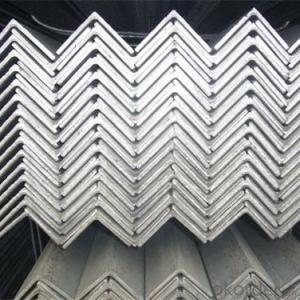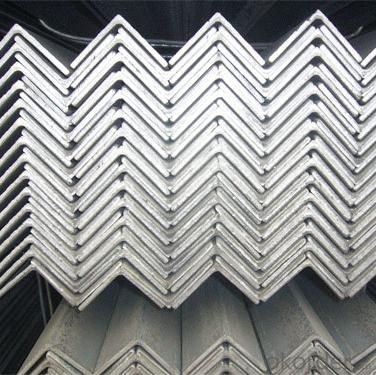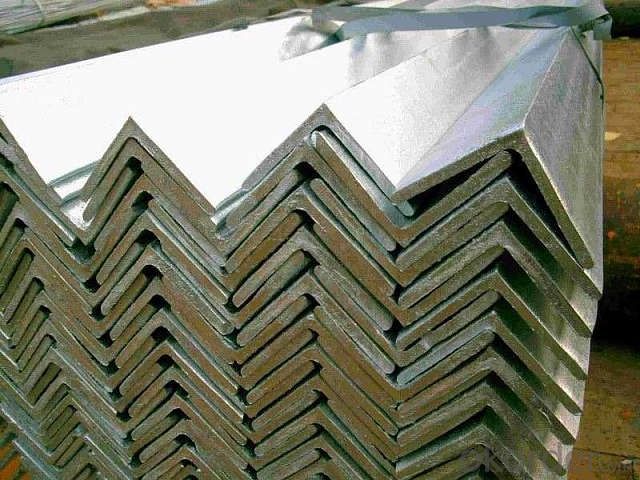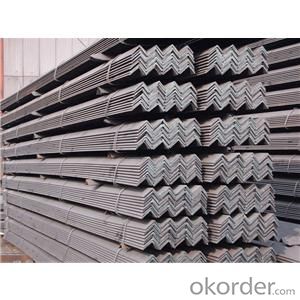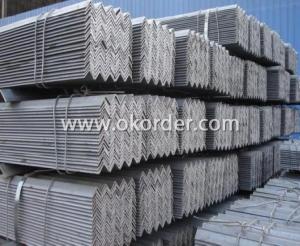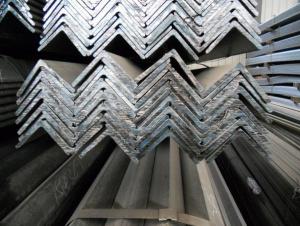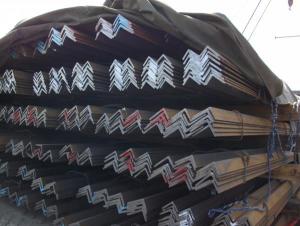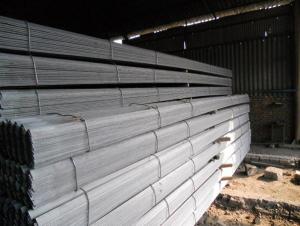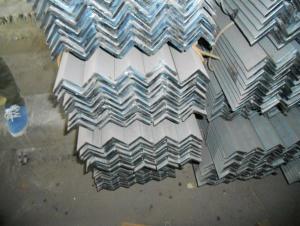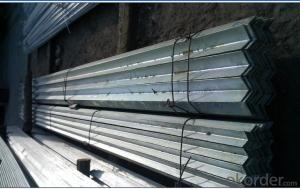Hot Rolled Equilateral Small Angle Steel
- Loading Port:
- Tianjin
- Payment Terms:
- TT or LC
- Min Order Qty:
- 25 m.t.
- Supply Capability:
- 2000 m.t./month
OKorder Service Pledge
OKorder Financial Service
You Might Also Like
Product Description:
OKorder is offering Hot Rolled Equilateral Small Angle Steel at great prices with worldwide shipping. Our supplier is a world-class manufacturer of steel, with our products utilized the world over. OKorder annually supplies products to European, North American and Asian markets. We provide quotations within 24 hours of receiving an inquiry and guarantee competitive prices.
Product Applications:
Hot Rolled Equilateral Small Angle Steel are ideal for structural applications and are widely used in the construction of buildings and bridges, and the manufacturing, petrochemical, and transportation industries.
Product Advantages:
OKorder's Hot Rolled Equilateral Small Angle Steel are durable, strong, and resist corrosion.
Main Product Features:
· Premium quality
· Prompt delivery & seaworthy packing (30 days after receiving deposit)
· Corrosion resistance
· Can be recycled and reused
· Mill test certification
· Professional Service
· Competitive pricing
Product Specifications:
Manufacture: Hot rolled
Grade: Q195 – 235
Certificates: ISO, SGS, BV, CIQ
Length: 6m – 12m, as per customer request
Packaging: Export packing, nude packing, bundled
Chinese Standard (H*W*T) | Weight (Kg/m) | 6m (pcs/ton) | Light I (H*W*T) | Weight (Kg/m) | 6m (pcs/ton) | Light II (H*W*T) | Weight (Kg/m) | 6M |
100*68*4.5 | 11.261 | 14.8 | 100*66*4.3 | 10.13 | 16.4 | 100*64*4 | 8.45 | 19.7 |
120*74*5.0 | 13.987 | 11.9 | 120*72*4.8 | 12.59 | 13.2 | 120*70*4.5 | 10.49 | 15.8 |
140*80*5.5 | 16.89 | 9.8 | 140*78*5.3 | 15.2 | 10.9 | 140*76*5 | 12.67 | 13.1 |
160*88*6 | 20.513 | 8.1 | 160*86*5.8 | 18.46 | 9 | 160*84*5.5 | 15.38 | 10.8 |
180*94*6.5 | 24.143 | 6.9 | 180*92*6.3 | 21.73 | 7.6 | 180*90*6 | 18.11 | 9.2 |
200*100*7 | 27.929 | 5.9 | 200*98*6.8 | 25.14 | 6.6 | 200*96*6.5 | 20.95 | 7.9 |
220*110*7.5 | 33.07 | 5 | 220*108*7.3 | 29.76 | 5.6 | 220*106*7 | 24.8 | 6.7 |
250*116*8 | 38.105 | 4.3 | 250*114*7.8 | 34.29 | 4.8 | 250*112*7.5 | 28.58 | 5.8 |
280*122*8.5 | 43.492 | 3.8 | 280*120*8.2 | 39.14 | 4.2 | 280*120*8 | 36.97 | 4.5 |
300*126*9 | 48.084 | 3.4 | 300*124*9.2 | 43.28 | 3.8 | 300*124*8.5 | 40.87 | 4 |
320*130*9.5 | 52.717 | 3.1 | 320*127*9.2 | 48.5 | 3.4 | |||
360*136*10 | 60.037 | 2.7 | 360*132*9.5 | 55.23 | 3 |
FAQ:
Q1: Why buy Materials & Equipment from OKorder.com?
A1: All products offered byOKorder.com are carefully selected from China's most reliable manufacturing enterprises. Through its ISO certifications, OKorder.com adheres to the highest standards and a commitment to supply chain safety and customer satisfaction.
Q2: How do we guarantee the quality of our products?
A2: We have established an advanced quality management system which conducts strict quality tests at every step, from raw materials to the final product. At the same time, we provide extensive follow-up service assurances as required.
Q3: How soon can we receive the product after purchase?
A3: Within three days of placing an order, we will begin production. The specific shipping date is dependent upon international and government factors, but is typically 7 to 10 workdays.
Q4: What makes stainless steel stainless?
A4: Stainless steel must contain at least 10.5 % chromium. It is this element that reacts with the oxygen in the air to form a complex chrome-oxide surface layer that is invisible but strong enough to prevent further oxygen from "staining" (rusting) the surface. Higher levels of chromium and the addition of other alloying elements such as nickel and molybdenum enhance this surface layer and improve the corrosion resistance of the stainless material.
Q5: Can stainless steel rust?
A5: Stainless does not "rust" as you think of regular steel rusting with a red oxide on the surface that flakes off. If you see red rust it is probably due to some iron particles that have contaminated the surface of the stainless steel and it is these iron particles that are rusting. Look at the source of the rusting and see if you can remove it from the surface.
Images:
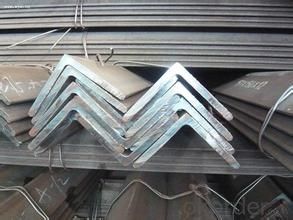
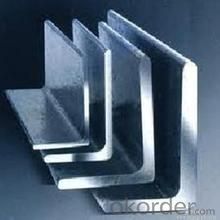
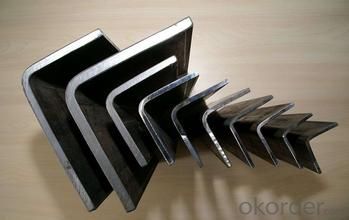
- Q: How do you prevent buckling of steel angles under compressive loads?
- To prevent steel angles from buckling under compressive loads, there are several steps that can be taken: 1. Increasing the section modulus: By broadening or thickening the steel angle, its ability to resist bending can be improved, thus enhancing its resistance to compressive loads without buckling. 2. Increasing the moment of inertia: The moment of inertia, which determines a cross-sectional shape's resistance to bending, can be increased by either adding more material or using a different shape with a greater moment of inertia. This makes the steel angle stiffer and less prone to buckling. 3. Providing lateral support: Lateral support can be provided by incorporating bracing or stiffeners into the steel angle. This helps distribute the compressive load and prevents buckling. The bracing or stiffeners should be designed to withstand the applied loads and prevent any local distortions or deformations. 4. Using thicker or higher strength steel: Thicker steel has a higher resistance to bending, while higher strength steel can bear greater stresses before reaching its yield point. By utilizing thicker or higher strength steel, the steel angle can withstand higher compressive loads without buckling. 5. Properly designing and installing connections: The connections between the steel angle and other structural components should be carefully designed and installed. Sufficient connection details should be provided to ensure proper transfer of the compressive load and adequate support for the steel angle. 6. Taking the effective length factor into consideration: The effective length factor is a parameter that considers the buckling behavior of a member. By accurately incorporating the effective length factor into design calculations, the risk of buckling can be minimized. 7. Conducting a comprehensive structural analysis: It is crucial to conduct a structural analysis to determine the expected compressive loads and potential buckling modes. By utilizing appropriate software or calculations, the necessary measures can be implemented to prevent buckling. In conclusion, preventing buckling of steel angles under compressive loads requires a combination of design considerations, material selection, and proper installation techniques. By following these measures, the structural integrity and safety of steel angles can be ensured in various applications.
- Q: Can steel angles be used for machine guards?
- Yes, steel angles can be used for machine guards. Steel angles are commonly used in the construction industry for their strength and durability. They can be easily fabricated and installed to create a protective barrier around machinery, ensuring the safety of workers and preventing accidents. The versatility of steel angles allows them to be customized to fit various machine sizes and shapes. Additionally, steel angles offer good impact resistance and can withstand heavy loads, making them suitable for use in machine guarding applications.
- Q: Can steel angles be used for fencing or gating?
- Yes, steel angles can be used for fencing or gating. Steel angles are often used in construction projects for their strength and durability. They can be used as posts or rails in fencing and gating systems, providing stability and support. Additionally, steel angles can be easily welded or bolted together to create various designs and configurations, making them a versatile choice for fencing and gating applications.
- Q: How do you protect steel angles from weathering?
- There are various effective methods available for protecting steel angles from weathering. The primary approach involves the application of a specially designed coating or paint that is intended for steel surfaces. This coating acts as a barrier, preventing direct contact between moisture, oxygen, and the steel, thereby reducing the likelihood of rust formation. It is crucial to select a weather-resistant coating that offers long-term durability. Before applying the protective coating, it is essential to thoroughly clean the steel angles to eliminate any dirt, grease, or existing rust. This can be accomplished through abrasive cleaning techniques such as sandblasting or by using a wire brush. Once the cleaning process is complete, the surface should be primed with a corrosion-resistant primer, which improves the adhesion of the protective coating. Regular maintenance is also vital to ensure the continuous protection of steel angles from weathering. This involves periodically inspecting the coating for any signs of damage or wear and promptly addressing any issues that arise. Touching up areas where the coating has been compromised is necessary to maintain the integrity of the protective layer. In addition, proper design and installation techniques can contribute to protecting steel angles from weathering. It is crucial to ensure that the angles are adequately sealed and shielded from direct exposure to rain, snow, or other sources of moisture. This can be achieved by implementing appropriate drainage systems, such as gutters or downspouts, to redirect water away from the steel angles. Lastly, considering alternative materials or coatings that possess inherent resistance to weathering, such as stainless steel or galvanized steel, can provide an additional layer of protection against environmental elements. These materials have higher corrosion resistance and are more suitable for outdoor applications where weathering is a concern. By implementing a combination of protective coatings, regular maintenance, proper design, and the utilization of weather-resistant materials, steel angles can be effectively safeguarded from weathering while maintaining their structural integrity over an extended period.
- Q: Are steel angles suitable for manufacturing structural beams?
- Yes, steel angles are suitable for manufacturing structural beams. Steel angles, also known as L-shaped structural steel, are commonly used in the construction industry to create structural beams due to their strength and versatility. Steel angles offer excellent load-bearing capabilities and are able to withstand heavy loads and forces, making them ideal for constructing beams that can support the weight of buildings, bridges, and other structures. Additionally, steel angles can be easily welded, bolted, or otherwise connected to form larger structural components, providing flexibility in design and construction. Overall, steel angles are a reliable and efficient choice for manufacturing structural beams.
- Q: How do steel angles compare to other structural shapes like beams and channels?
- Construction and engineering projects often utilize steel angles, beams, and channels as structural shapes. These shapes each possess distinct characteristics and advantages, but steel angles specifically offer unique benefits that contribute to their popularity. The versatility of steel angles is a key advantage. They can be employed in various applications, such as supporting heavy loads, bracing structures, and creating frameworks. With their L-shaped design, steel angles can be easily joined together through welding or bolting to construct larger structures or frameworks. In terms of cost-effectiveness, steel angles tend to be more economical compared to steel beams. They require less material for manufacturing, making them a more budget-friendly option for projects with financial constraints. Furthermore, steel angles are typically lighter in weight than beams, which can be advantageous for transportation and installation expenses. On the other hand, steel channels provide similar benefits to steel angles but possess a distinct shape. Channels possess a U-shaped design, offering enhanced stability and support. They are commonly utilized in applications that demand increased strength, such as the construction of bridges, buildings, and machinery. While steel angles may not offer the same level of strength and load-bearing capacity as steel beams or channels, they remain a reliable choice for numerous structural applications. Their versatility, cost-effectiveness, and ease of installation make them a preferred option for a broad range of construction and engineering projects.
- Q: Are steel angles suitable for corrosive environments?
- Corrosive environments can be suitable for steel angles depending on the specific conditions and the type of steel utilized. Stainless steel angles, for instance, exhibit exceptional resistance against corrosion due to their composition rich in chromium and nickel. These angles find extensive application in environments that encounter moisture, chemicals, or saltwater, such as marine applications or industrial settings. On the other hand, carbon steel angles may not be as appropriate for corrosive environments as they tend to be more susceptible to rust and corrosion. In such instances, it may be necessary to employ additional protective measures like coatings or galvanization to enhance their resistance against corrosion. To determine the most suitable steel angles for corrosive environments, it is crucial to consider the specific corrosive elements present in the environment, the extent of exposure, and the desired longevity of the angles. Seeking guidance from a corrosion specialist or an engineer with expertise in materials selection can aid in making informed decisions.
- Q: What are the common defects or issues found in steel angles?
- There are several common defects or issues that can be found in steel angles, which can affect their structural integrity and performance. Here are some of the most frequently encountered: 1. Surface imperfections: Steel angles may have surface defects such as scratches, pits, or uneven coating. While these may not significantly affect the strength of the angle, they can impact its visual appearance and corrosion resistance. 2. Warping: Warping refers to the distortion or bending of the steel angle along its length. This defect can occur during the manufacturing process or due to improper handling or storage. Warped angles may not fit properly in applications where precise dimensions are required. 3. Flaws in dimensions: Steel angles should be manufactured to specific dimensions and tolerances. However, defects like undersized or oversized legs, unequal leg lengths, or inconsistent thickness can occur. These flaws can lead to problems during installation or compromise the structural integrity of the angle. 4. Lack of straightness: Steel angles should be straight along their length to ensure proper alignment and load distribution. However, they can sometimes exhibit a lack of straightness, commonly known as bowing or crooking. This defect can make it challenging to align angles accurately and may result in uneven stress distribution. 5. Internal cracks: Cracks within the steel angle are a significant concern as they can compromise its strength and load-bearing capacity. These cracks can occur during manufacturing due to improper cooling or quenching processes, or they can be a result of excessive stress or corrosion. Internal cracks are often not visible to the naked eye, making it crucial to perform non-destructive testing methods like ultrasound or magnetic particle inspection. 6. Corrosion: Steel angles are susceptible to corrosion, especially in environments with high humidity, moisture, or exposure to chemicals. Corrosion can weaken the structure and affect the angle's overall performance. Regular maintenance and proper coating or protective measures are necessary to prevent or minimize corrosion-related defects. It is essential to identify and address these defects or issues promptly to ensure the safety and reliability of steel angles in various applications, from construction and infrastructure to manufacturing and fabrication. Regular quality checks, adherence to industry standards, and appropriate maintenance practices can help mitigate these problems and ensure the longevity of steel angles.
- Q: Can steel angles be used for pipe supports?
- Yes, steel angles can be used for pipe supports. Steel angles provide a strong and durable option for supporting pipes due to their structural integrity and load-bearing capabilities. The L-shaped design of steel angles offers excellent stability and can be easily mounted to walls, ceilings, or other structural elements. Additionally, steel angles can be welded or bolted together to create custom configurations that suit specific pipe support requirements. Their versatility, strength, and ease of installation make steel angles a popular choice for pipe support applications in various industries such as construction, plumbing, and manufacturing.
- Q: What are the different surface coating options for steel angles?
- There are several different surface coating options available for steel angles, depending on the specific requirements and desired properties. Some of the most common options include: 1. Galvanizing: This is a popular coating method where a layer of zinc is applied to the steel surface. Galvanizing provides excellent corrosion resistance, making it suitable for outdoor applications or environments with high moisture levels. 2. Powder coating: Powder coating involves electrostatically applying a dry powder to the steel surface, which is then cured through heat to form a durable and smooth coating. It offers a wide variety of colors and finishes while providing good corrosion resistance and aesthetics. 3. Paint: Painting is another common coating method that involves applying a layer of paint to the steel surface. Paint offers a range of colors and finishes, and it can provide corrosion protection when combined with a suitable primer. 4. Epoxy coating: Epoxy coatings are known for their exceptional corrosion resistance and chemical resistance. They are often used in environments with exposure to chemicals or harsh conditions. Epoxy coatings can be applied as a liquid or powder and are cured to form a hard and protective layer. 5. Phosphate coating: Phosphate coatings are typically used as a pre-treatment before painting or powder coating. They provide improved adhesion and corrosion resistance, acting as a base layer for subsequent coatings. 6. Anodizing: Anodizing is typically used for aluminum, but it can also be applied to steel. It involves creating a layer of oxide on the surface, which enhances corrosion resistance and provides a decorative finish. It is important to consider factors such as the intended application, environmental conditions, aesthetic preferences, and budget when selecting the appropriate surface coating option for steel angles. Consulting with coating specialists or experts can help in determining the best coating option for specific requirements.
Send your message to us
Hot Rolled Equilateral Small Angle Steel
- Loading Port:
- Tianjin
- Payment Terms:
- TT or LC
- Min Order Qty:
- 25 m.t.
- Supply Capability:
- 2000 m.t./month
OKorder Service Pledge
OKorder Financial Service
Similar products
Hot products
Hot Searches
Related keywords
